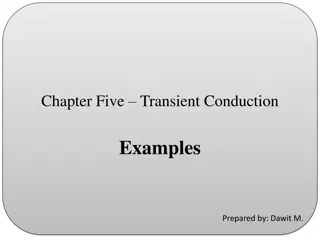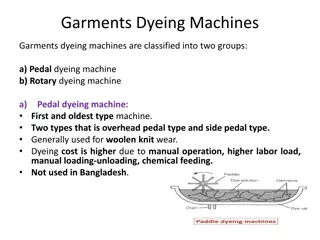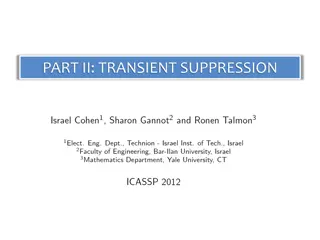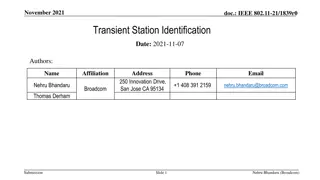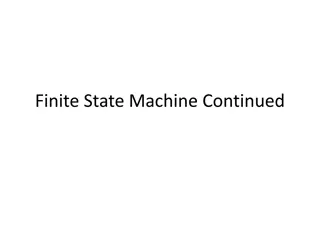Understanding Weird Machines in Transient Execution
Weird machines refer to models exhibiting unintentional behaviors triggered by adversarial inputs. They serve as computation primitives, enabling tasks like program obfuscation and secret computations. TSX weird machines, computing with time, manipulate cache states through gates like Assign, AND, OR, XOR, providing unique capabilities and limitations on various CPU architectures. Further research aims to generalize these concepts to support multiple CPU types and enhance security against static analysis.
Download Presentation

Please find below an Image/Link to download the presentation.
The content on the website is provided AS IS for your information and personal use only. It may not be sold, licensed, or shared on other websites without obtaining consent from the author. Download presentation by click this link. If you encounter any issues during the download, it is possible that the publisher has removed the file from their server.
E N D
Presentation Transcript
The ghost is the machine: Weird machines in transient execution Ping-Lun Wang, Fraser Brown, Riad S. Wahby WOOT, 05/25 2023
What are weird machines? Definition: models a system s unintentional behavior, usually triggered from adversarial input Use weird machines as computation primitives Perform program obfuscation or secret computations o The MOV instruction[1] o Page fault handler[2] o Time (TSX WM)[3] [1] S. Dolan, mov is Turing-complete (2013) [2] J. Bangert et al., The page-fault weird machine: Lessons in instruction-less computation (WOOT 2013) [3] D. Evtyushkin et al., Computing with time: Microarchitectural weird machines (ASPLOS 2021) 2
TSX weird machines that compute with time[3] Input I2 in cache? Input I1 in cache? = 0 I2 short latency 1 0 Cache hit Cache miss long latency = 1 I1 TSX Weird Gate Cache Fetch output Out into cache? 3 [3] D. Evtyushkin et al., Computing with time: Microarchitectural weird machines (ASPLOS 2021)
TSX weird machines that compute with time[3] Input I2 in cache? I2 Input I1 in cache? I1 I2 Out AND I1 Cache Out TSX Weird Gate I2 I1 I2 Out OR I1 Cache Fetch output Out into cache? Out 4 [3] D. Evtyushkin et al., Computing with time: Microarchitectural weird machines (ASPLOS 2021)
TSX weird machines that compute with time[3] Input I2 in cache? Input I1 in cache? Compute on cache states ( Arch) Not visible in architectural states! TSX Weird Gate Gates: Assign, AND, OR, XOR Fetch output Out into cache? 5 [3] D. Evtyushkin et al., Computing with time: Microarchitectural weird machines (ASPLOS 2021)
TSX weird machines that compute with time[3] Input I2 in cache? Input I1 in cache? Limitations TSX instructions are easy to detect TSX Weird Gate o Vulnerable to static analysis! Limited to some Intel CPUs o AMD and ARM CPUs are not supported! Fetch output Out into cache? 6 [3] D. Evtyushkin et al., Computing with time: Microarchitectural weird machines (ASPLOS 2021)
Our work: generalize TSX WM to Transient WM TSX any transient execution primitive! Cache TSX Side channel o Prevent static analysis o Support AMD, ARM, and Intel CPUs o 95~99% accuracy on all CPUs New NOT gate design Meltdown Assign AND Spectre OR XOR NOT Transient execution primitives o Idea: cache state controls the length of transient execution o Leads to a 7X faster XOR gate Weird gates Transient weird machine (WM) 7
What is transient execution? PC clflush(X); TSX { AX /= 0; X[0] = 0; } X DIV by 0!! (Waiting ) (Speculative) Transient execution ends! Cache (Modified!!) Transient execution begins! Transient execution (TSX) 8
Generalize TSX WM to other primitives INIT: SIGFPE { goto EXIT; clflush(X); TSX { AX /= 0; X[0] = 0; } } clflush(X); AX /= 0; X[0] = 0; EXIT: Transient execution (TSX) Transient execution (Meltdown) 9
Assign: input latency controls output variable Out INIT: I is in cache Cache I I[0] = 0; SIGFPE { goto EXIT; } Fetch I[0] Fetch Out[0] = 0 Assign DIV by 0!! Transient exec. I Out clflush(Y); AX /= 0; Out[I[0]] = 0; EXIT: ... I is NOT in cache Cache Fetch Out[0] Fetch I[0] = 0 Assign Assign gate DIV by 0!! Transient exec. 10
From Assign to OR & AND gates INIT: I[0] = 0; SIGFPE { goto EXIT; } Out[I1[0]] = 0; Out[I2[0]] = 0; OR gate clflush(Y); AX /= 0; Out[I[0]] = 0; EXIT: ... Out[I2[I1[0]]] = 0; AND gate Assign gate 11
How to construct a NOT gate? Fetch output when input is not in cache I in cache fast Assign How to fetch output when input is slow? AX /= 0; Out[I[0]] = 0; I not in cache slow Assign Assign gate Too slow to fetch output Transient exec. DIV by 0!! Time 12
How to construct a NOT gate? Input Fetch output AX /= I[0]; Out[tmp[0]] = 0; NOT Time NOT gate I in cache fast Transient exec. DIV by 0!! I not in cache slow Transient exec. DIV by 0!! Slow input Slow transient exec. Insight: transient execution time is not constant! 13
NOT: input latency controls transient execution time tmp Out INIT: I is in cache Cache I I[0] = O[0] = 0; SIGFPE { goto EXIT; } Fetch tmp[0] Fetch Out[0] NOT Transient exec. DIV by 0!! Fetch I[0] Division clflush(O); clflush(tmp); AX /= I[0]; Out[tmp[0]] = 0; EXIT: ... I tmp Out I is NOT in cache Cache Fetch tmp[0] Fetch Out[0] NOT DIV by 0!! Transient exec. Fetch I[0] Division NOT gate 14
Measuring accuracy and runtime Test on 3 CPUs o AMD EPYC 7R13 o ARM Graviton 1 o Intel Xeon E7-8800 Implementation 1M operations Repeat 1,000 times Weird Gates o C/C++ and asm o 1,379 LoC o Available on GitHub* Median accuracy & runtime 15 *https://github.com/joeywang4/Transient-Weird-Machine
Accuracy and runtime Gate AMD Intel ARM Gate AMD Intel ARM 99.96% 99.99% AND 1.801 2.628 32.521 AND 98.89% OR 100.00% 99.99% 99.46% OR 1.756 2.551 32.506 Assign 99.99% 99.99% 99.42% Assign 1.751 2.637 32.378 NOT 99.51% 99.99% 99.29% NOT 1.779 2.741 32.573 XOR 94.36% 95.58% 97.97% XOR 7.403 15.648 130.898 MUX 98.17% 99.93% 97.64% MUX 5.870 11.975 131.150 Accuracy Runtime (s/Mops) 16
Application: program obfuscation Obfuscate computations and control flows Future work: compiler to construct circuits of weird gates input password if (input ^ password) { fail(); } else { success(); } success fail Obfuscate with Transient WM XOR MUX Function pointer 17
Takeaways TSX WMs + Meltdown & Spectre Transient WMs Novel NOT gate design Obfuscate malware and attack exploits Github: https://github.com/joeywang4/Transient-Weird-Machine Authors: Ping-Lun Wang, Fraser Brown, Riad S. Wahby Contact: pinglunw@andrew.cmu.edu Thank you for listening! 18






